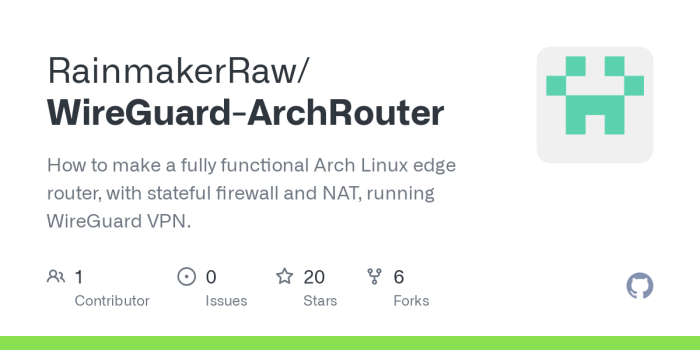WireGuard is a cutting-edge VPN technology that offers unparalleled performance, security, and ease of use. Its innovative architecture and modern cryptography make it an ideal solution for a wide range of use cases, including remote access, secure tunneling, and network segmentation.
In this comprehensive guide, we will delve into the world of WireGuard on Arch Linux, exploring its benefits, installation process, configuration options, and more.
As a leading Linux distribution known for its bleeding-edge software and customization capabilities, Arch Linux is an excellent platform for WireGuard. By leveraging the power of Arch Linux, users can unlock the full potential of WireGuard and enjoy a secure, high-performance VPN experience.
WireGuard on Arch Linux

WireGuard is a modern and versatile VPN solution that provides a secure and efficient way to establish virtual private networks (VPNs). It is an excellent choice for Arch Linux users due to its lightweight nature, high performance, and ease of use.
To install WireGuard on Arch Linux, follow these steps:
- Update your system:
sudo pacman
-Syu
- Install the WireGuard package:
sudo pacman
-S wireguard-tools
- Generate a new private key:
wg genkey | tee privatekey | wg pubkey | tee publickey
- Create a new WireGuard interface:
sudo wg-quick up wg0
- Configure the WireGuard interface:
sudo nano /etc/wireguard/wg0.conf
- Add the following lines to the configuration file:
[Interface] PrivateKey = $(cat privatekey)
Address = 10.0.0.1/24
ListenPort = 51820
- Add a peer to the WireGuard interface:
sudo nano /etc/wireguard/wg0.conf
- Add the following lines to the configuration file:
[Peer] PublicKey = $(cat publickey)
AllowedIPs = 10.0.0.2/32
- Save the configuration file and restart the WireGuard interface:
sudo systemctl restart wg-quick@wg0
Once you have completed these steps, you will have successfully installed and configured WireGuard on Arch Linux. You can now use WireGuard to establish secure and private VPN connections.
WireGuard offers a wide range of configuration options that allow you to customize your VPN connection. Some of the most common configuration options include:
- PrivateKey: The private key used to generate the public key and establish the VPN connection.
- Address: The IP address of the WireGuard interface.
- ListenPort: The port on which the WireGuard interface listens for incoming connections.
- PublicKey: The public key of the peer that you want to connect to.
- AllowedIPs: The IP addresses that are allowed to connect to the WireGuard interface.
You can learn more about WireGuard configuration options by reading the official WireGuard documentation.
WireGuard vs. OpenVPN on Arch Linux
WireGuard and OpenVPN are two of the most popular VPN protocols available for Arch Linux. Both protocols have their own advantages and disadvantages, so it’s important to understand the differences between them before choosing one.In terms of performance, WireGuard is generally faster than OpenVPN.
This is because WireGuard uses a simpler encryption algorithm than OpenVPN, which results in less overhead. In addition, WireGuard is designed to be more efficient than OpenVPN, which also contributes to its improved performance.In terms of security, WireGuard is also considered to be more secure than OpenVPN.
This is because WireGuard uses a modern encryption algorithm that is not susceptible to the same attacks as the encryption algorithm used by OpenVPN. In addition, WireGuard is designed to be more resistant to eavesdropping and other types of attacks.In
terms of ease of use, WireGuard is generally considered to be easier to use than OpenVPN. This is because WireGuard is a newer protocol that has been designed with simplicity in mind. OpenVPN, on the other hand, is a more complex protocol that can be more difficult to configure and use.
Comparison Table
The following table summarizes the key differences between WireGuard and OpenVPN:| Feature | WireGuard | OpenVPN ||—|—|—|| Performance | Faster | Slower || Security | More secure | Less secure || Ease of use | Easier to use | More difficult to use |
Pros and Cons
The following are some of the pros and cons of using WireGuard and OpenVPN on Arch Linux:WireGuardPros:* Faster performance
- More secure
- Easier to use
Cons:* Newer protocol, so less support
May not be as stable as OpenVPN
OpenVPNPros:* More mature protocol, so more support
- More stable than WireGuard
- More features than WireGuard
Cons:* Slower performance
- Less secure
- More difficult to use
WireGuard Network Topology
WireGuard supports various network topologies, allowing for flexible and customizable network configurations.
A typical WireGuard network topology involves a central server (or multiple servers) connected to multiple clients. The server acts as a gateway, routing traffic between the clients and the external network.
Point-to-Point Topology
In a point-to-point topology, each client establishes a direct connection with the server. This topology is simple to configure and provides high performance, as traffic is not routed through multiple hops.
Mesh Topology
In a mesh topology, each client can communicate directly with every other client. This topology is more resilient than point-to-point, as it provides multiple paths for traffic to flow in case of a server outage.
Star Topology
In a star topology, all clients connect to a central server. This topology is easier to manage than mesh topology, but it is less resilient, as all traffic must pass through the server.
WireGuard Performance Optimization
WireGuard is known for its exceptional performance, but there are factors that can affect its speed and efficiency. Optimizing WireGuard’s performance involves identifying these factors and implementing appropriate measures.
Identifying Factors Affecting WireGuard Performance
- Network latency: The time it takes for data to travel between devices.
- CPU overhead: The amount of processing power required to encrypt and decrypt data.
- MTU size: The maximum size of data packets that can be sent over the network.
- WireGuard configuration: The settings and parameters used to configure WireGuard.
Tips on Optimizing WireGuard Performance
- Reduce network latency: Use a wired connection or a high-speed wireless network.
- Use a powerful CPU: A faster CPU will handle encryption and decryption more efficiently.
- Adjust MTU size: Experiment with different MTU sizes to find the optimal value for your network.
- Optimize WireGuard configuration: Enable fast handshake and disable unnecessary features to improve performance.
Trade-offs Between Performance and Security
Optimizing WireGuard performance may involve trade-offs with security. For example, disabling certain security features can improve speed but reduce protection.
It’s crucial to strike a balance between performance and security based on your specific requirements and threat model.
WireGuard Security Considerations
WireGuard is renowned for its robust security features, employing state-of-the-art cryptographic protocols to ensure data confidentiality, integrity, and authenticity.
Cryptographic Protocols
WireGuard utilizes ChaCha20 for encryption, a stream cipher known for its speed and security. It also employs Poly1305 for message authentication, ensuring data integrity. The handshake process is protected by the Curve25519 elliptic curve algorithm, providing forward secrecy and preventing eavesdropping.
Potential Security Risks
Despite its robust security, WireGuard is not immune to potential risks:
Misconfiguration
Improper configuration can compromise security. Ensure proper key management and network settings to mitigate this risk.
Key Compromise
The security of WireGuard relies heavily on the secrecy of its keys. If keys are compromised, the entire network can be compromised.
Protocol Vulnerabilities
While WireGuard is considered secure, it is not immune to future vulnerabilities. Stay informed about any updates or security advisories.
Mitigating Security Risks
To enhance WireGuard security, consider the following recommendations:
Strong Key Management
Use strong and unique keys for both server and client configurations.
Proper Configuration
Carefully configure WireGuard settings to ensure security and prevent misconfigurations.
Regular Updates
Stay up-to-date with the latest WireGuard versions and security patches to address any potential vulnerabilities.
Network Segmentation
Implement network segmentation to isolate critical resources from potential threats.
Monitor Network Traffic
Monitor network traffic to detect and respond to any suspicious activity.
WireGuard Troubleshooting

WireGuard is a secure and easy-to-use VPN, but like any software, it can encounter problems. This guide will help you identify and resolve common WireGuard problems.
If you are having trouble with WireGuard, the first step is to check the documentation. The WireGuard website has a wealth of information on troubleshooting, including a FAQ and a troubleshooting guide.
If you cannot find the answer to your problem in the documentation, you can try searching for it online. There are many forums and websites that can provide help with WireGuard.
If you are still having trouble, you can contact the WireGuard developers. They are very responsive and helpful.
Common Problems
- Cannot connect to the VPN
- Slow VPN speeds
- DNS leaks
- IPv6 leaks
- WireGuard crashes
Advanced Troubleshooting
If you are experiencing a complex WireGuard problem, you may need to use advanced troubleshooting techniques. These techniques can be found in the WireGuard documentation.
Here are some tips for advanced troubleshooting:
- Use a packet sniffer to capture and analyze network traffic.
- Use a VPN log analyzer to analyze WireGuard logs.
- Contact the WireGuard developers for help.
WireGuard Use Cases
WireGuard is a versatile VPN solution with numerous applications in various scenarios. It offers robust security, high performance, and user-friendliness, making it suitable for a wide range of use cases.
Here are some common use cases for WireGuard:
Remote Access to Corporate Networks
WireGuard is an ideal solution for providing secure remote access to corporate networks. It allows employees to connect to the company’s internal network from anywhere, enabling them to access files, applications, and other resources as if they were physically present in the office.
WireGuard’s strong encryption and efficient performance ensure a seamless and secure remote work experience.
Establishing Private Networks Between Devices
WireGuard can be used to create private networks between multiple devices, such as laptops, smartphones, and servers. This is useful for securely connecting devices that are not on the same local network, allowing them to communicate as if they were directly connected.
For example, you can use WireGuard to create a private network between your home computer and your laptop when you’re away from home, enabling you to access your home network’s resources securely.
Building Virtual Private Networks (VPNs)
WireGuard is a powerful tool for building VPNs. It offers a secure and reliable way to encrypt and route traffic between two or more devices, allowing users to establish private and secure connections over public networks. WireGuard’s ease of use and cross-platform compatibility make it a popular choice for creating VPNs for personal and business use.
Bypassing Geo-Restrictions and Censorship
WireGuard can be used to bypass geo-restrictions and censorship imposed by governments or ISPs. By connecting to a VPN server in a different country, users can access websites and content that would otherwise be blocked in their region. WireGuard’s high performance and strong encryption make it an effective tool for circumventing censorship and accessing global content.
Conclusion
WireGuard is a versatile VPN solution with numerous use cases. Its robust security, high performance, and user-friendliness make it suitable for a wide range of applications, including remote access, private network establishment, VPN building, and bypassing geo-restrictions. Whether you’re looking to secure your remote work connection, establish private networks between devices, or access global content, WireGuard is an excellent choice.
WireGuard Community Resources
The WireGuard community is a vibrant and supportive group of users, developers, and enthusiasts who are passionate about the project. There are many ways to get involved in the community, and there are a number of resources available to help users get started.
Online Resources
There are a number of online resources available for WireGuard users, including:
- The WireGuard website: https://www.wireguard.com
- The WireGuard documentation: https://www.wireguard.com/docs/
- The WireGuard mailing list: https://lists.zx2c4.com/mailman/listinfo/wireguard
- The WireGuard IRC channel: #wireguard on Freenode
- The WireGuard subreddit: https://www.reddit.com/r/WireGuard/
These resources provide a wealth of information about WireGuard, including tutorials, documentation, and support from the community.
Getting Involved
There are a number of ways to get involved in the WireGuard community, including:
- Contributing to the WireGuard project
- Translating the WireGuard documentation
- Helping to answer questions on the mailing list or IRC channel
- Writing blog posts or articles about WireGuard
- Giving presentations about WireGuard at conferences or meetups
Participating in the WireGuard community is a great way to learn more about the project, help others, and contribute to its development.
Benefits of Participating
There are a number of benefits to participating in the WireGuard community, including:
- Access to the latest information about WireGuard
- Support from the community
- The opportunity to contribute to the development of WireGuard
- The chance to meet other people who are interested in WireGuard
If you are interested in learning more about WireGuard or getting involved in the community, I encourage you to check out the resources listed above.
WireGuard Future Development

WireGuard is an actively developed project, and the future roadmap includes several exciting features and improvements. One of the most significant developments is the integration of WireGuard into the Linux kernel. This will allow WireGuard to take advantage of the kernel’s networking stack, which will improve performance and stability.Another
major development is the addition of support for IPv6. This will allow WireGuard to be used with IPv6 networks, which are becoming increasingly common.In addition to these major developments, the WireGuard team is also working on a number of other features, including:* Improved performance
- Increased security
- More user-friendly interface
- Support for more platforms
The future of WireGuard is very promising. The project is actively developed, and the team is committed to making WireGuard the best possible VPN solution.
WireGuard’s Roadmap
The WireGuard team has released a roadmap for the future development of WireGuard. The roadmap includes the following milestones:*
-*Q1 2023
Release WireGuard 1.0
-
- -*Q2 2023
Integrate WireGuard into the Linux kernel
- -*Q2 2023
-*Q3 2023
Add support for IPv6
-*Q4 2023
Release WireGuard 2.0
The WireGuard team is also working on a number of other features, including:* Improved performance
- Increased security
- More user-friendly interface
- Support for more platforms
The WireGuard roadmap is subject to change, but it provides a good overview of the team’s plans for the future.
WireGuard Best Practices
WireGuard is a relatively new VPN protocol, but it has quickly gained popularity due to its simplicity, speed, and security. However, like any other technology, there are certain best practices that should be followed to ensure that WireGuard is used securely and efficiently.
Here are some of the best practices for using WireGuard:
- Use strong encryption algorithms. WireGuard supports a variety of encryption algorithms, including ChaCha20, AES-256, and BLAKE2s. It is important to use a strong encryption algorithm to protect your data from eavesdropping.
- Use a strong key. The WireGuard key is used to encrypt and decrypt data. It is important to use a strong key to protect your data from being decrypted by unauthorized users.
- Keep your software up to date. WireGuard is constantly being updated with new features and security fixes. It is important to keep your software up to date to ensure that you are using the latest and most secure version.
- Use a firewall to block unwanted traffic. A firewall can help to protect your WireGuard server from unauthorized access. It is important to configure your firewall to allow only the traffic that you want to allow.
- Monitor your WireGuard server. It is important to monitor your WireGuard server to ensure that it is running properly and that there are no unauthorized connections.
By following these best practices, you can help to ensure that your WireGuard server is secure and efficient.
Outcome Summary
In conclusion, WireGuard on Arch Linux is a powerful and versatile VPN solution that offers a compelling combination of performance, security, and flexibility. Whether you are a seasoned network administrator or a home user seeking a secure and reliable way to connect to remote networks, WireGuard on Arch Linux is an excellent choice.
Embrace the future of VPN technology and unlock the possibilities of secure and private networking.